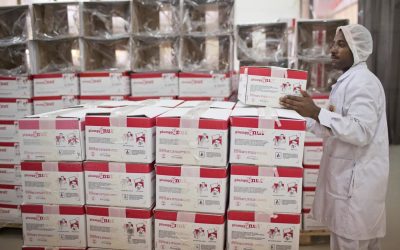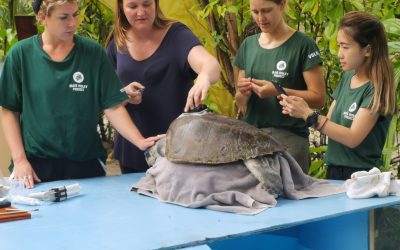Since then, we have tested even more types of thermal sensors and come up with our favorites for use in the Arctic with polar bears and India with elephants, two of the more problematic species creating human-wildlife conflict.

Left to right: Heimann 80×64, ULIS Micro80 Gen2 (above), Melexis 90640 (below), FLIR Lepton 2.5
Here’s a summary of their strengths and weaknesses:


| ULIS Micro80 Gen2 shutter-less microbolometer | |
| Pixel Resultion: 80×80 | NETD (noise level): 100 mK |
| Pros: | Cons: |
| Good signal-to-noise ratio for the sensors we are testing | As a microbolometer, it requires frequent recalibration or image correction for accurate reading |
| Best pixel resolution of sensors we are testing | As a shutter-less microbolometer, image calibration is complicated |
| Shutter-less design will work in cold Arctic conditions | Moderate cost when compared to thermopile sensors |
| Uses: Identifying the hot or cold objects in a scene where conditions are below 0°C or any interruption of the view via shutter is problematic | |
| FLIR Lepton 2.5 shuttered microbolometer | |
| Pixel Resolution: 80 x 60 | NETD (Noise level): 50 mK |
| Pros: | Cons: |
| Best signal-to-noise ratio of the sensors we are testing | Shuttered microbolometer design will not work in the Arctic below 0°C as a mechanical shutter may freeze |
| Good pixel resolution | Moderate cost when compared to thermopile sensors |
| Requires frequent calibration or image correction, but the shutter design makes this uncomplicated | |
| Ideal for deployment in most climates | |
| Uses: Identifying the hot or cold objects in a scene where conditions are above 0°C and a small interruption of viewing the shutter is not problematic | |


| Heimann 80×64 Thermopile | |
| Pixel Resolution: 80×64 | NETD (noise level): 400 mK |
| Pros: | Cons: |
| Good pixel resolution for sharper edges | Very low signal-to-noise ratio making temperatures differences difficult to distinguish, resulting in poor image quality |
| Will operate in a wide range of temperatures from the Arctic to India | |
| Does not require frequent recalibration | |
| Lower cost compared to microbolometers | |
| Uses: finding hot and cold objects or regions in a scene where object identification is not important | |


| MELEXIS MLX90640 thermopile | |
| Pixel resolution: 32×24 | NETD (noise level): 100mk |
| Pros: | Cons: |
| Good signal-to-noise ratio for the sensors we are testing | Lower pixel resolution than microbolometers sensors we are testing |
| Will operate in a wide range of temperatures from the Arctic to India | Very low signal-to-noise ratio making temperatures differences difficult to distinguish, resulting in poor image quality |
| Does not require frequent recalibration | |
| Lower cost compared to microbolometers | |
| Uses: finding hot and cold objects or regions in a scene where object identification is not important | |
As we found with our preliminary testing, microbolometers out-performed thermopiles in terms of image quality. They generally have less noise when properly calibrated, resulting in more detailed images needed for automated identification. Microbolometers do have disadvantages when compared with thermopiles; they require frequent calibration to keep noise out of images and some may not work in all temperature ranges. Thermopiles could be a powerful thermal imaging tool with improvements in noise level and pixel resolution, especially if their cost remains low. For now however, we are concentrating on microbolometers to give us the image quality needed to program auto recognition of animals.
We have chosen two of the lower resolution microbolometer sensors we believe will give us the needed image quality at the lowest cost: FLIR Lepton 2.5 shuttered microbolometer and the ULIS Micro80 Gen2 shutterless microbolometer. These sensors have similar pixel resolutions and noise levels, but the Lepton 2.5 uses a shutter to perform period image corrections to remove noise. These mechanical shutters make image correction easy to program, but in cold arctic temperatures may freeze. Without the shutter to remove noise from the image, it will become degraded. A shutterless microbolometer like the Micro80 Gen2 will still perform in cold weather, but the calibration process is more complicated and involves more up-front work. For these reasons, we’ve chosen the Lepton 2.5 for imaging in climates about 0°C, most elephant climates, and the Micro80 Gen2 for the arctic.
With the help of Whipsnade Zoo and the Yorkshire Wildlife Park, we tested both sensors with elephants and polar bears.
Elephant Testing at Whipsnade Zoo

Thermal image of feeding elephants

Optical image of feeding elephants
Elephants proved fairly easy subjects. Their size and warm skin temperature make the easy for people to identify in thermal images. It’s possible for a person to identify the thermal image of an elephant from at least 15 meters away.

Elephant 15 meters from sensor

Elephant 12 meters from sensor
The images above show elephants standing in the indoor and outdoor areas of the enclosure. The consistent and cool background temperatures of the indoor enclosure make the elephant stand out nicely. Outdoors, background temperatures can be much warmer when sitting out in the sun. This can make it more difficult for an elephant to stand out. It is one challenge of thermal imaging animals outdoors.

Thermal image of an elephant’s backside

Thermal image of an elephant behind metal bars
Other considerations to identify elephants are the direction it’s facing relative to the sensor and the surrounding material. The image on the left shows two elephants: one in the background with its side to the camera and its trunk in the air and in the foreground whose backside if facing the camera. The elephant in the background appears easier to identify by its side profile. You might have a hard time identifying the elephant in front with only its backside. This may help decide where to place sensor in the field and in what kind of pattern. Having cameras facing all angles will more likely catch an elephant in profile, where its easier to identify. The image on the right shows and elephant behind the metal bars of its enclosure. Material, such as metal or concrete, that heats up in the sun is more likely to obscure the heat coming from an elephant. More material in front of the elephant will also obscure its shape, making it more difficult to identify even if its heat stands out.
Polar Bear Testing at Yorkshire Wildlife Park

Polar bear in its outdoor enclosure
Polar bears the trickier to see in thermal than elephants. They are extremely well insulated, which makes their outer temperature very cool and often close to the surrounding temperature of the ground, even in the snowy arctic. However, testing at Yorkshire wildlife park showed it is possible to get a thermal image of a polar bear, even if they don’t stand out the way the elephants did.

Polar bear walking on a ridge 11 meters from sensor

Polar bear sitting on the ground 7 meters away from sensor
The left image shows a polar bear waking along a ridge 11 meters away from the camera and 3 meters above. It’s possible to identify the shape of the bear silhouetted against the skyline. If the bear had been on the slope and not the ridge, it may have blended in with the heat of the ground and been more difficult to identify. The right image shows a polar bear 7 meters away from the camera, sitting on the ground. Its head and front feet are the easiest to identify because they are less insulated with fur. A good portion of the body is a very similar temperature to the background, making it blend in.

Polar bear walking 5 meters from sensor

Polar bear sitting on the grass 4 meters away from sensor
There are some tricks to seeing a polar bear in thermal. As seen in the left image, when the bears are walking or standing, it’s easier to identify their whole profile, even it doesn’t stand out from the background temperature very strongly. Placing an array of sensors in the field in areas where bears are known pass by would increase the likelihood of identification. The image on the right shows bears cool outer temperature can be an advantage. If the bear is walking in an area cleared of snow or in front of a building or a wall heated from the sun, it may stand out as cooler than its background. Because these sensors are to be placed in community areas where polar bears frequent, we are more likely to have buildings or snow-free areas to help identify the bears.
The ultimate goal for recognition of these animals to automate identification with a computer algorithm. With our preliminary zoo testing, we were focusing on the image quality needed for a human to identify the elephant or polar bear. Computers recognize object in photographs in different ways, sometimes with less information than a person needs to make an identification. We have sent our zoo collected footage to machine learning experts to analyze and let us know if it’s possible for a computer to make a positive ID.
In the meantime, we are building our prototype field systems to test in Greenland and India. This will be the first real test of how these sensors respond in field conditions that are much less controlled and how well they detect the animal’s presence. We will also be able to test different installation methods and array set-ups which can be incorporated into our final design.
Stay tuned for updates on our prototype build, algorithm development and field trial results!









0 Comments